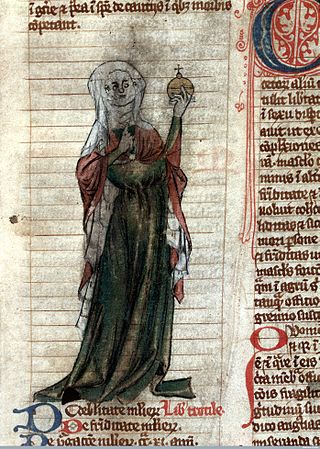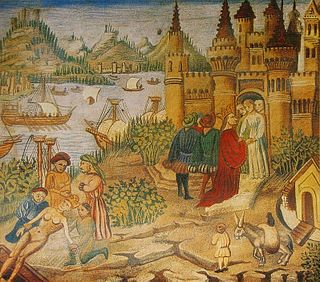Related Research Articles

The history of medicine is both a study of medicine throughout history as well as a multidisciplinary field of study that seeks to explore and understand medical practices, both past and present, throughout human societies.

The University of Bologna is a public research university in Bologna, Italy. Founded in 1088 by an organised guild of students (studiorum), it is the oldest university in continuous operation in the world, and the first degree-awarding institution of higher learning. At its foundation, the word universitas was first coined. The university's emblem carries the motto, Alma Mater Studiorum, the date A.D. 1088. With over 90,000 students, the University of Bologna is one of the largest universities in Europe.

Trotula is a name referring to a group of three texts on women's medicine that were composed in the southern Italian port town of Salerno in the 12th century. The name derives from a historic female figure, Trota of Salerno, a physician and medical writer who was associated with one of the three texts. However, "Trotula" came to be understood as a real person in the Middle Ages and because the so-called Trotula texts circulated widely throughout medieval Europe, from Spain to Poland, and Sicily to Ireland, "Trotula" has historic importance in "her" own right.

Abū al-Qāsim Khalaf ibn al-'Abbās al-Zahrāwī al-Ansari, popularly known as al-Zahrawi (الزهراوي), Latinised as Albucasis or Abulcasis, was a physician, surgeon and chemist from al-Andalus. He is considered one of the greatest surgeons of the Middle Ages.

The Schola Medica Salernitana was a medieval medical school, the first and most important of its kind. Situated on the Tyrrhenian Sea in the south Italian city of Salerno, it was founded in the 9th century and rose to prominence in the 10th century, becoming the most important source of medical knowledge in Western Europe at the time.

Laura Maria Caterina Bassi Veratti was an Italian physicist and academic. Recognized and depicted as "Minerva", she was the first woman to have a doctorate in science, and the second woman in the world to earn the Doctor of Philosophy degree. Working at the University of Bologna, she was also the first salaried female teacher in a university. At one time the highest paid employee of the university, by the end of her life Bassi held two other professorships. She was also the first female member of any scientific establishment, when she was elected to the Academy of Sciences of the Institute of Bologna in 1732 at 21.

Elena Lucrezia Cornaro Piscopia or Elena Lucrezia Corner, also known in English as Helen Cornaro, was a Venetian philosopher of noble descent who in 1678 became one of the first women to receive an academic degree from a university and the first to receive a Doctor of Philosophy degree.

Dorotea Bocchi (1360–1436) was an Italian noblewoman known for studying medicine and philosophy. Dorotea was associated with the University of Bologna, though there are differing beliefs regarding the extent of her participation at the university ranging, from whether she taught or held a position there. Despite these debates, there is consensus that she flourished and was active at the university for more than 40 years, beginning from 1390 onwards.
Abella, often known as Abella of Salerno or Abella of Castellomata, was a physician in the mid fourteenth century. Abella studied and taught at the Salerno School of Medicine. Abella is believed to have been born around 1380, but the exact time of her birth and death is unclear. Abella lectured on standard medical practices, bile, and women's health and nature at the medical school in Salerno. Abella, along with Rebecca de Guarna, specialized in the area of embryology. She published two treatises: De atrabile and De natura seminis humani, neither of which survive today. In Salvatore De Renzi's nineteenth-century study of the Salerno School of Medicine, Abella is one of four women mentioned who were known to practice medicine, lecture on medicine, and wrote treatises. These attributes placed Abella into a group of women known as the Mulieres Salernitanae, or women of Salerno.

Monique Frize,, née Aubry is a Canadian biomedical engineer and professor, knowledgeable in medical instruments and decision support systems. Notably, her scientific research and outreach efforts led her to receive the prestigious distinction of Officer of the Order of Canada.

Islamic psychology or ʿilm al-nafs, the science of the nafs, is the medical and philosophical study of the psyche from an Islamic perspective and addresses topics in psychology, neuroscience, philosophy of mind, and psychiatry as well as psychosomatic medicine. In Islam, mental health and mental illness were viewed with a holistic approach. This approach emphasized the mutual connection between maintaining adequate mental wellbeing and good physical health in an individual. People who practice Islam thought it was necessary to maintain positive mental health in order to partake in prayer and other religious obligations.

Ewald Rudolf Weibel HonFRMS was a Swiss anatomist and physiologist and former director of the Institute of Anatomy at the University of Bern. He was one of the first scientists to describe the endothelial organelles Weibel–Palade bodies, which are named after him and his Romanian-American colleague George Emil Palade. He was known for his work on the anatomy of gas exchange in lungs on multiple spatial scales using stereology.
Constance Calenda was an Italian surgeon specializing in diseases of the eye. She studied at the University of Salerno, and was one of the women known as the "ladies of Salerno".

The history of pharmacy as a modern and independent science dates back to the first third of the 19th century. Before then, pharmacy evolved from antiquity as part of medicine. The history of pharmacy coincides well with the history of medicine, but it's important that there is a distinction between the two topics. Pharmaceuticals is one of the most-researched fields in the academic industry, but the history surrounding that particular topic is sparse compared to the impact its made world-wide. Before the advent of pharmacists, there existed apothecaries that worked alongside priests and physicians in regard to patient care.
Bartholomaeus of Bruges was a Flemish physician and natural philosopher.
The history of hospitals began in antiquity with hospitals in Greece, the Roman Empire and on the Indian subcontinent as well, starting with precursors in the Asclepian temples in ancient Greece and then the military hospitals in ancient Rome. The Greek temples were dedicated to the sick and infirm but did not look anything like modern hospitals. The Romans did not have dedicated, public hospitals. Public hospitals, per se, did not exist until the Christian period. Towards the end of the 4th century, the "second medical revolution" took place with the founding of the first Christian hospital in the eastern Byzantine Empire by Basil of Caesarea, and within a few decades, such hospitals had become ubiquitous in Byzantine society. The hospital would undergo development and progress throughout Byzantine, medieval European and Islamic societies from the 5th to the 15th century. European exploration brought hospitals to colonies in North America, Africa, and Asia. St Bartholomew's hospital in West Smithfield in London, founded in 1123, is widely considered the oldest functioning hospital today. Originally a charitable institution, currently an NHS hospital it continues to provide free care to Londoners, as it has for 900 years. In contrast, the Mihintale Hospital in Sri Lanka, established in the 9th century is probably the site with the oldest archaeological evidence available for a hospital in the world. Serving monks and the local community, it represents early advancements in healthcare practices.

Trota of Salerno was a medical practitioner and writer in the southern Italian coastal town of Salerno who lived in the early or middle decades of the 12th century. Her fame spread as far as France and England in the 12th and 13th centuries. A Latin text that gathered some of her therapies was incorporated into an ensemble of treatises on women's medicine that came to be known as the Trotula, "the little book [called] 'Trotula'". Gradually, readers became unaware that this was the work of three different authors. They were also unaware of name of the historical writer, which was "Trota" and not "Trotula". The latter was thenceforth misunderstood as the author of the whole compendium. These misconceptions about the author of Trotula contributed to the erasure or modification of her name, gender, level of education, medical knowledge, or the time period in which the texts were written; this trend often resulted from the biases of later scholars. Trota's authentic work was forgotten until it was rediscovered in the late 20th century.
Adelle of the Saracens was an Italian physician. She belonged to the Saracinensa family and was a lay teacher at the medical faculty of Salerno. Her medical practice stemmed from roots in the Salerno Medical School and she practiced Medieval and Early Italian Renaissance Ideals in her medicine including Humanism.
Jacques Mering was a Lithuanian-born, naturalised French engineer well known in the fields of X-ray crystallography and mineralogy. He earned the degree of Diploma in Electrical Engineering from École Spéciale des Travaux Publics, and Bachelor of Science from Faculté des sciences. He served in the French Army for a year during 1931–1932 following conscription. He was director of research at the Centre National de Recherche Scientifique in Paris, and subsequently Director of CNRS Laboratory in Orléans.

The women of Salerno, also referred to as the ladies of Salerno and the Salernitan women, are a group of women physicians who studied in medieval Italy, at the Schola Medica Salernitana, one of the first medical schools to allow women.
References
- 1 2 Boggi, Pina Cavallo (2023), Marsico, Giuseppina; Tateo, Luca (eds.), "Women and Popular Medicine", Humanity in Psychology: The Intellectual Legacy of Pina Boggi Cavallo, Theory and History in the Human and Social Sciences, Cham: Springer International Publishing, pp. 25–34, doi:10.1007/978-3-031-30640-2_3, ISBN 978-3-031-30640-2 , retrieved 2024-01-29
- ↑ Stevenson, Jane (2022-09-01), "Women and Latin in the Early Modern Period", Women and Latin in the Early Modern Period, Brill, pp. 1–116, ISBN 978-90-04-52976-2 , retrieved 2024-01-29
- ↑ Green, Monica (January 1989). "Women's Medical Practice and Health Care in Medieval Europe". Signs: Journal of Women in Culture and Society. 14 (2): 434–473. doi:10.1086/494516. ISSN 0097-9740.
- ↑ Frize, Monique (2013), Frize, Monique (ed.), "Women in Science and Medicine in Europe Prior to the Eighteenth Century", Laura Bassi and Science in 18th Century Europe: The Extraordinary Life and Role of Italy's Pioneering Female Professor, Berlin, Heidelberg: Springer, pp. 25–37, doi:10.1007/978-3-642-38685-5_3, ISBN 978-3-642-38685-5 , retrieved 2024-01-29
- ↑ DeBakcsy, Dale (2022). "A History of Women in Medicine and Medical Research : Exploring the Trailblazers of STEM": 1–216.
{{cite journal}}: Cite journal requires|journal=(help) - ↑ L. Whaley: Women and the Practice of Medical Care in Early Modern Europe, 1400-1800
- ↑ Proffitt, Pamela (1999). Notable Women Scientists . Detroit: Gale Group. pp. 1. ISBN 0787639001.